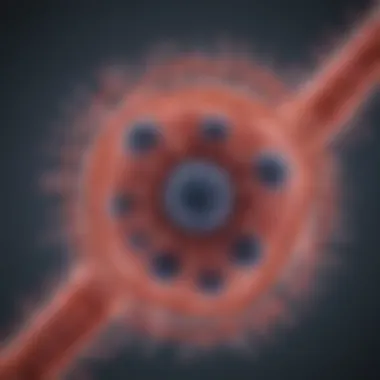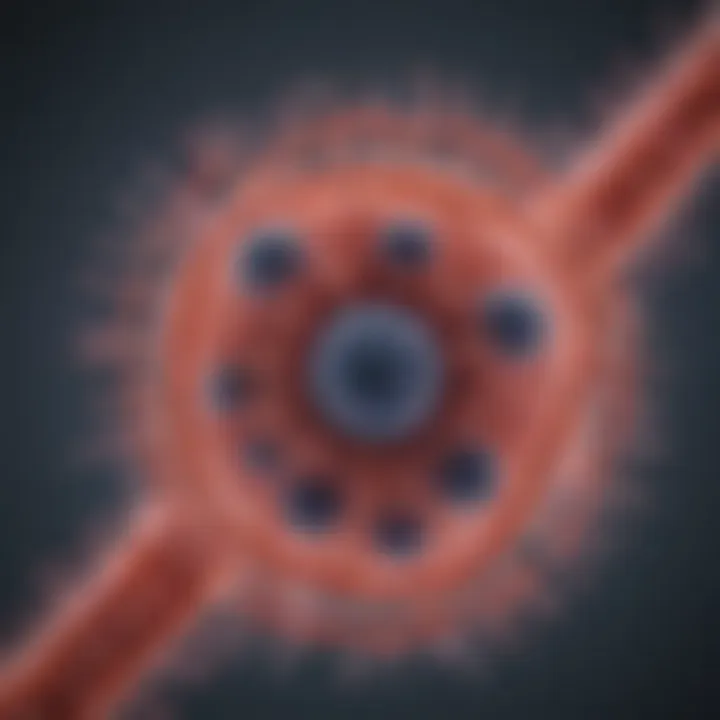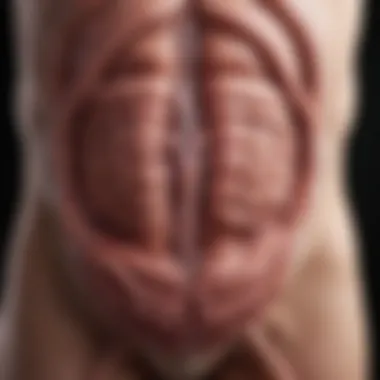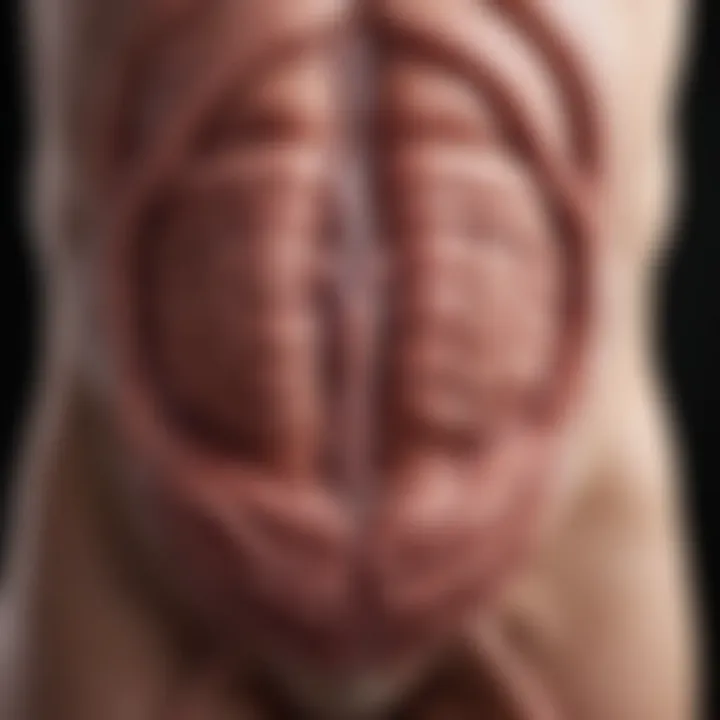Understanding Escherichia Coli Infections in Urine


Intro
Escherichia coli, a type of bacteria that hangs around like a bad penny, often gets a lot of attention when it comes to urinary tract infections. It’s a common culprit in causing these infections, affecting countless individuals each year. Understanding how this little bugger operates could make a significant difference in managing and treating the issue. This section takes a closer look at the complexities of Escherichia coli infections in the urine, shedding light on the symptoms people experience, how these infections are diagnosed, available treatments, and prevention strategies.
Recent Advances
Latest Discoveries
In recent times, researchers have been on the lookout for new insights into E. coli infections. Among the latest discoveries is the recognition that not all E. coli strains are created equal. Some strains are more virulent than others. Understanding these variations can lead to better diagnosis and tailored treatment plans. For instance, studies suggesting a direct connection between the virulence factors of specific strains and the severity of urinary tract infections might revolutionize how practitioners address these common issues.
Technological Innovations
The field of micro-biology is seeing some fascinating tech-driven innovations. Polymerase chain reaction (PCR) techniques have seen a boon—allowing for quicker and more accurate detection of E. coli strains in patient samples. This kind of technology not only shortens the time to diagnosis but also aids in determining susceptibility patterns, which is critical for effective treatment options. Rapid diagnostic tests using CRISPR technology are also emerging, enabling healthcare professionals to swiftly assess the presence of specific bacteria and their resistance genes. Such advancements are monumental in driving forward patient care.
Methodology
Research Design
Understanding E. coli infections necessitates a well-thought-out research design. Many studies employ a combination of retrospective and prospective methods, exploring patient histories while also gathering live data from new cases. This two-pronged approach ensures a robust understanding of the risk factors and outcomes associated with E. coli infections in the urinary tract.
Data Collection Techniques
Data collection is where the rubber meets the road. Patient interviews, laboratory cultures, and urine sample analyses play a central role in this process. Researchers also utilize epidemiological data to track infection patterns across demographics and regions. By combining these varied techniques, healthcare professionals can craft a comprehensive portrait of how E. coli behaves within different populations, paving the way for targeted interventions.
"By delving into the intricate relationship between E. coli and urinary tract health, we enhance our understanding and pave the way for better management options."
Through comprehensive understanding, we can tackle urinary tract infections more effectively, armed with a deeper knowledge of Escherichia coli and its impacts.
Prolusion to Escherichia Coli
Understanding Escherichia coli, commonly known as E. coli, is crucial for grasping the complexities of urinary tract infections (UTIs). This bacterium can be both a friend and foe in human health. While many strains of E. coli play a vital role in our gut, aiding in digestion and providing essential nutrients, certain pathogenic strains can wreak havoc when they ascend the urinary tract. By delving into the characteristics and roles of E. coli, we can lay a robust foundation for discussing how it becomes a primary culprit in UTIs.
General Characteristics of Escherichia Coli
E. coli is a versatile, rod-shaped bacterium, falling under the family Enterobacteriaceae. It thrives in various environments, with a particularly strong presence in the intestines of warm-blooded organisms. This species is characterized by its gram-negative cell wall structure, which renders it resistant to certain antibiotics and gives it a unique ability to adapt rapidly to various conditions.
The majority of E. coli strains are harmless, yet their pathogenic varieties can lead to severe infections. For instance, one notable feature is the ability of some strains to form biofilms, structures that protect them from both the immune system and antibiotics. These biofilms can form on the urinary tract's delicate lining, leading to persistent infections.
Additionally, these bacteria can produce virulence factors, such as fimbriae and toxins, which aid in their colonization and persistence in host tissues. This gives them a leg up when it comes to invading the urinary tract, often leading to the symptoms associated with UTIs.
E. coli and its Role in Human Health
As a major inhabitant of the human gut flora, E. coli is vital for maintaining gut health. It assists in breaking down food, producing vitamins, and preventing the establishment of harmful bacteria. However, this balanced relationship can shift. For example, when there is an imbalance in gut flora, or when certain strains make their way into the urinary tract, E. coli can become pathogenic.
"Not all E. coli are created equal; some are allies, while others can be marked enemies, particularly when they invade areas they shouldn't be."
Research indicates that the pathogenic varieties can lead to economic burdens due to healthcare costs associated with UTIs. These infections are not only a concern for individual health but also highlight the importance of monitoring and understanding bacterial behavior within the urinary tract.
In summary, E. coli stands as a double-edged sword in human health. While vital for a functioning digestive system, its potential to cause infection emphasizes the need for awareness and understanding of this bacterium in the broader context of health, particularly in relation to urinary tract infections.
Understanding Urinary Tract Infections
Understanding Urinary Tract Infections (UTIs) serves as a pivotal component in grasping the broader implications of Escherichia coli infections. UTIs are not just a nuisance; they reflect the intricate and often fragile nature of human health, particularly concerning the urogenital system. This article specifically hones in on how E. coli, a bacterium commonly found in the intestines, takes center stage in UTI diagnoses and treatments. By dissecting UTIs, we can unveil the challenges healthcare providers face while also recognizing the vital role patients play in prevention.
In particular, knowing the types and underlying mechanisms of UTIs enriches our understanding of how to effectively combat these infections. Moreover, with growing resistance patterns seen in E. coli, it becomes ever more crucial to analyze these infections thoroughly and devise strategies for management and prevention.
Definition and Overview of UTIs
A Urinary Tract Infection occurs when bacteria invade the urinary system, typically in the bladder and urethra. UTIs can manifest in two primary forms: lower UTIs, which impact the bladder, and upper UTIs, affecting the kidneys. According to health organizations, UTIs rank among the most common bacterial infections worldwide, notably impacting women. The defining characteristic is the presence of symptoms, such as urgency, frequency, and a burning sensation during urination.
Types of Urinary Tract Infections
UTIs can be categorized into two main branches—lower UTIs and upper UTIs —each presenting unique characteristics and implications.
Lower UTIs
When discussing lower UTIs, a common aspect to highlight is the bladder infection, known as cystitis. This condition is characterized by inflammation caused by bacterial infection, primarily from Escherichia coli. Lower UTIs are prevalent in young women, often linked to hygiene practices or sexual activity. Clinically, they appear more manageable; symptoms are typically localized and treatable with straightforward antibiotic courses.
One unique feature of lower UTIs is that they may clear up rapidly with appropriate treatment, yet recurrence is not uncommon, particularly in those prone to infections. This presents both a challenge and an advantage. While quick recovery is appealing, the constant cycle of infections can lead to significant discomfort and health implications.
Upper UTIs
Upper UTIs, in contrast, encompass infections of the kidneys or ureters, known as pyelonephritis. The severity of upper UTIs often eclipses that of lower ones. Patients may experience systemic symptoms such as fever and chills, indicating a more intense response from the body’s immune system. Unlike lower UTIs, these infections can require hospitalization if severe enough, emphasizing the necessity of prompt diagnosis and treatment.
A distinct feature of upper UTIs is their potential for complications. Left untreated, they can lead to permanent kidney damage or even life-threatening conditions like sepsis. Hence, understanding upper UTIs emphasizes the importance of not just treating the symptoms but also taking preventive measures, especially for populations at risk.


"Prevention is better than cure, especially when it comes to URIs, which can affect one’s overall quality of life.”
The interplay between lower and upper UTIs underlines their place within the wider dialogue of infections caused by E. coli. Knowledge of both facets is essential for crafting effective management strategies and developing a nuanced understanding of the disease process.
E. coli as a Pathogen in Urinary Tract Infections
Escherichia coli, commonly acknowledged in the medical literature, takes center stage as a leading cause of urinary tract infections (UTIs). This significance arises from its ubiquitous nature and the specific strains that manifest pathogenic properties. Recognizing E. coli’s role as a pathogen in UTIs is paramount for appropriate clinical management and patient education.
In discussions surrounding urinary health, one can't overlook the sheer prevalence of E. coli as a culprit. The bacterium does not just reside harmlessly in the intestines; certain strains have adapted to breach the urogenital barrier, leading to infections and complications. The insights into why and how E. coli transforms from a benign gut inhabitant to a dangerous adversary in urinary infections are crucial. Without this comprehension, treatment strategies might not yield the desired outcomes and might create a substantial burden on healthcare resources.
Pathogenic Strains of E. coli
Among the diverse strains of E. coli, a select few are infamous for their role in urinary infections. The most notorious of these is uropathogenic Escherichia coli (UPEC), which is primarily responsible for community-acquired UTIs. UPEC possesses specific virulence factors that enhance its ability to colonize the bladder and ascend the urinary tract. Notably, adhesins enable these bacteria to cling firmly to the uroepithelial cells, making it difficult for the host’s immune response to clear them.
Other pathogenic strains include enterotoxigenic E. coli (ETEC) and enterohemorrhagic E. coli (EHEC), though they're primarily associated with gastrointestinal diseases, they sometimes play a role in urinary tract infections, particularly when the host's defenses are compromised or altered. The overlap of virulence factors across these strains emphasizes the need to discern their presence in practical situations and clinical settings.
Mechanisms of Infection
The mechanisms through which E. coli causes urinary tract infections are multifaceted and fascinating. Once E. coli breaches the urogenital area, it employs several tactics to establish infection.
- Adhesion: The first step is adhesion to the uroepithelium. UPEC expresses various fimbriae or pili, which are hair-like structures that allow these bacteria to latch onto the bladder walls. Without this initial stickiness, the risk of infection diminishes considerably.
- Biofilm Formation: After adhering, E. coli can form biofilms, a slippery coating that protects bacterial colonies from both the immune system and antibiotic action. Biofilms are notorious for their role in chronic infections; once established, they are challenging to eradicate.
- Invasion and Evasion: E. coli can invade uroepithelial cells, essentially hijacking the host's own cells as shields against immune responses. The bacteria can exploit host cell machinery to replicate and persist within cells, creating reservoirs that escape detection.
- Toxin Production: Some strains produce toxins that can damage host tissues, provoking inflammation and further exacerbating symptoms. These toxins also play a role in altering local immune responses, helping the bacteria survive in an otherwise hostile environment.
- Ascending Infection: In severe cases, bacteria can ascend from the bladder to the kidneys, potentially leading to pyelonephritis, a far more serious condition. This pathway highlights the importance of timely treatment to prevent complications.
Understanding how E. coli transitions from a harmless gut bacterium to a significant pathogen in urinary tract infections offers invaluable insights for both prevention and management strategies in clinical practice.
The implications of E. coli as a pathogen are immense, underscoring the necessity of improved diagnostic, treatment, and preventive measures in tackling urinary tract infections effectively. The intimate relationship between bacteria and the host underscores the complexity of urologic health, emphasizing that preventive strategies must be tailored to address the diverse mechanisms involved.
Clinical Presentation of E. coli Urinary Infections
Understanding the clinical presentation of E. coli urinary infections is crucial. These infections are among the most common reasons patients seek medical attention. Recognizing symptoms early can lead to prompt diagnosis and treatment, reducing the risk of complications that can stem from untreated infections.
Symptoms and Signs
The symptoms of an E. coli urinary infection can vary greatly from person to person but generally fall into two main categories: lower urinary tract symptoms and systemic signs. Common signs include:
- Frequent urination: This may feel like an urgent need but results in limited amounts of output.
- Dysuria: Painful urination is a hallmark symptom, leading individuals to associate discomfort directly with their need to void.
- Foul-smelling or cloudy urine: Changes in urine appearance can signal an infection, while unusual odors may arise due to increased bacteria.
- Pressure or pain in the lower abdomen: This discomfort can signify inflammation in the bladder.
- Chills or fever: When the infection ascends to the kidneys, systemic signs like fever can appear, indicating a more serious condition.
Patients often describe a feeling akin to a persistent itch or irritation, leading to significant distress in daily activities. Awareness of these symptoms encourages individuals to seek medical advice sooner rather than later.
Complications Associated with UTIs
Complications could arise from E. coli urinary infections, affecting not only individual health but also public well-being due to increased healthcare costs and antibiotic usage. Understanding these potential complications emphasizes the importance of timely treatment.
Pyelonephritis
Pyelonephritis is a severe type of kidney infection that can result from an initial bladder infection. Patients typically present with severe symptoms, including:
- Flank pain: Pain around the back or sides, often more intense than lower abdominal pain.
- High fever: Systemic signs of infection can emerge, distinguishing it from lower urinary tract symptoms.
- Nausea and vomiting: These additional symptoms can complicate the clinical picture and suggest that an individual may be quite ill.
This condition is worth detailing because, unlike lower UTIs, pyelonephritis can lead to serious complications, including renal scarring and chronic kidney disease. Individuals suffering from this condition may require hospitalization, highlighting its impact on public health. Prompt identification and treatment can prevent long-term damage to the kidneys.
Sepsis
Sepsis represents a severe body-wide response to an infection that can result from an untreated E. coli urinary infection. It’s characterized by:
- Confusion or altered mental state: This reflects severe stress on the body system, emphasizing the urgency for medical intervention.
- Rapid heart rate and breathing: As the body reacts to the infection, vital signs can change dramatically.
- Low blood pressure: This can lead to shock if not addressed, making sepsis a medical emergency.
Sepsis is included in this discussion because it underscores the potential dreadfulness of urinary infections. If caught early, treatments may be effective; however, delayed intervention can lead to mortality. This highlights the critical need for effective diagnostic and therapeutic strategies in managing E. coli infections.
"Timely identification of urinary infections is essential to prevent the escalation to more severe complications such as pyelonephritis and sepsis."
In summary, recognizing the clinical presentation of E. coli urinary infections and their potential complications is pivotal for effective healthcare delivery. These insights will also solidify the foundation for subsequent discussions regarding diagnosing and treating these infections.
Diagnosing E. coli Urinary Infections
Diagnosing Escherichia coli urinary infections is critical for effective treatment and management. The implications of accurately identifying the causative agent of a UTI extend beyond mere symptom relief; they encompass the prevention of recurrent infections and complications. Urinary tract infections can lead to serious health issues if left untreated, hence understanding how to correctly diagnose them can save patients considerable discomfort and mitigate the risk of more severe conditions, such as kidney infections.
Laboratory Tests and Procedures
Urinalysis
Urinalysis is a primary tool in diagnosing a UTI. It involves a multi-faceted approach that examines the physical, chemical, and microscopic properties of urine. One key aspect of urinalysis is its ability to detect the presence of nitrites, leukocytes, and blood, all of which can indicate a bacterial infection.
Urinalysis shines in its speed; results can be obtained relatively quickly, often within a few hours, making it a favored choice in both emergency and outpatient settings. This characteristic of timeliness is invaluable, particularly because it allows for immediate treatment to begin without delay.
However, urinalysis does have its limitations. While it may provide strong indicators of infection, it cannot definitively identify the specific strain of E. coli present. This means that while it is effective for fast preliminary processes, it should only be considered the first step in the diagnostic pathway.


Urine Culture
Urine culture takes the analysis one step further by isolating the bacteria present in urine. Its main advantage lies in its specificity; through this method, healthcare providers can not only identify the presence of E. coli but also determine its antibiotic susceptibility. This attribute makes urine culture a cornerstone in tailoring effective treatment plans for patients.
One unique feature of urine culture is its ability to identify mixed infections, which can complicate treatment. Knowing whether E. coli is present alongside other pathogens influences the course of management substantially. Although urine culture is considered a gold standard test, it’s important to note that it requires time—typically around 24 to 48 hours—for results, which can delay immediate intervention.
Interpreting Results
Once the appropriate tests are administered, interpreting the results becomes the next crucial step. For urinalysis, the presence of
- Nitrites: Suggests the presence of Gram-negative bacteria, most commonly E. coli.
- Leukocyte esterase: Indicates white blood cells, signaling potential inflammation or infection.
In contrast, urine culture results will reveal not only whether E. coli is present but also its concentration and susceptibility to various antibiotics. Interpreting these results correctly empowers healthcare professionals to make informed decisions regarding patient care, optimizing treatment outcomes and reducing the likelihood of resistant strains emerging.
Overall, the diagnostic process for E. coli urinary infections involves both timely urinalysis and detailed urine culture, each contributing unique insights into the patient's condition. By understanding and effectively utilizing these methods, healthcare providers can navigate the complex landscape of urinary tract infections with greater efficiency.
"Timely and accurate diagnosis is the bedrock of effective health care delivery."
Understanding these components helps ensure that patients receive the most appropriate care tailored to their specific needs.
Treatment Options for E. coli Infections
The effective management of Escherichia coli infections in the urinary tract is paramount, not only for the immediate health of the affected individuals but also for the broader implications on public health. As the most common bacterial cause of urinary tract infections (UTIs), understanding treatment options is essential for healthcare providers and patients alike. This section will delve into the critical components of treatment strategies, highlighting antibiotic therapy, exploring resistance patterns, and addressing their implications for therapeutic practices.
Antibiotic Therapy
Antibiotic therapy remains the cornerstone for treating E. coli-induced urinary infections. The choice of antibiotic can greatly influence the recovery process and the likelihood of complications. Typically, the first-line agents include trimethoprim-sulfamethoxazole, nitrofurantoin, and phosphomycin. These drugs are favored due to their potency against E. coli and their favorable safety profiles.
The duration of treatment often ranges from three to seven days, depending on the severity of the infection, as well as the patient’s individual health status.
Antibiotics do work wonders, but they are not a perfect fit for all. Side effects like nausea, diarrhea, or even allergic reactions may occur. Moreover, it is essential to note that the inappropriate use of antibiotics can lead to increased resistance, which complicates future treatment options. Regular monitoring of patient responses to therapy can also inform adjustments if initial treatments do not yield desired outcomes.
Resistance Patterns
Understanding resistance patterns of E. coli is crucial, especially in light of increasing reports of antibiotic-resistant strains. High rates of resistance have been documented for commonly prescribed antibiotics.
Mechanisms of Resistance
Resistance in E. coli can occur through various mechanisms. One prominent method is the production of beta-lactamases, enzymes that break down antibiotics like penicillin. This strategy enables the bacteria to withstand the effects of treatment that would typically eradicate them.
Another mechanism involves the alteration of drug target sites, minimizing the antibiotics’ effectiveness. Additionally, efflux pumps can actively expel antibiotics from the bacterial cell, rendering them ineffective.
These resistance characteristics not only put patients at risk of treatment failure but also make selecting effective antibiotics a challenging task.
Implications for Treatment
The implications of antibiotic resistance on treatment are substantial. First and foremost, the effectiveness of standard antibiotics can be compromised, necessitating the use of more potent and often more expensive alternative treatments. This situation can lead to prolonged illnesses and increased healthcare costs.
Furthermore, physicians may be compelled to prescribe broader-spectrum antibiotics, which can disrupt normal flora and inevitably lead to additional complications, like Clostridium difficile infections. Awareness of local resistance patterns is essential for healthcare providers to tailor antibiotic therapy appropriately.
In summary, the management of E. coli urinary infections involves a careful selection of antibiotic therapy, alongside a deep understanding of resistance mechanisms. Awareness and implementation of these strategies are vital steps towards effective treatment and enhancing patient well-being.
Prevention Strategies
Preventing Escherichia coli infections, particularly those affecting the urinary tract, is a crucial aspect of managing public health. The importance of this topic cannot be overstated, as urinary tract infections (UTIs) represent a significant burden on healthcare systems. Prevention strategies can dramatically reduce the incidence of these infections and improve the quality of life for numerous individuals. Key elements of prevention include personal hygiene practices and management of risk factors, both of which play critical roles in combating this issue.
Personal Hygiene Practices
Implementing good personal hygiene practices is fundamentally important. These routines help to create a barrier against E. coli entering the urinary tract. Below are several actionable practices:
- Wiping Techniques: It’s advisable to wipe from front to back after using the bathroom. This reduces the likelihood of bacteria from the rectal area traveling toward the urethra.
- Regular Bathing: Maintaining overall cleanliness through regular bathing is essential.
- Cotton Underwear: Wearing breathable materials such as cotton can help keep the genital area dry and reduce bacterial growth.
- Avoiding Irritants: Products like douches or scented feminine hygiene products can disrupt the natural flora and may lead to infections.
Incorporating these practices into daily routines can have a positive impact, reducing the risk of recurrent infections considerably.
Management of Risk Factors
In addition to personal hygiene, understanding and managing risk factors is paramount for preventing E. coli infections. A number of elements can predispose individuals to UTIs. Some of these include:
- Dehydration: Inadequate fluid intake can lead to a reduction in urine output, decreasing the flushing out of bacteria.
- Sexual Activity: Increased frequency of sexual intercourse can elevate the risk of infections, especially if not proper precautions, like urinating before and after, are observed.
- Hormonal Changes: Women, particularly post-menopausal females, experience fluctuations in estrogen levels, impacting the balance of urogenital flora.
- Chronic Conditions: Individuals with diabetes or urinary tract abnormalities need heightened vigilance, as these conditions can influence bacterial growth and adherence within the urinary tract.
Addressing these risk factors requires a multifaceted approach that includes education and regular consultations with healthcare providers.
"The best cure is prevention. A proactive approach can help to mitigate risks and lead to better health outcomes."
In summary, adopting stringent personal hygiene practices, while simultaneously managing the associated risk factors, forms a solid foundation for preventing Escherichia coli infections. By fostering healthier habits and awareness, both individuals and healthcare systems can collectively work towards reducing the prevalence of UTIs, thereby paving the way for improved public health.


E. coli Infection in Special Populations
Escherichia coli infections hold specific significance in certain demographics, especially among the elderly and women. These groups often face unique challenges that make them more vulnerable to urinary tract infections (UTIs) caused by E. coli. Delving into this topic helps illuminate the necessary considerations for treatment and prevention strategies across different age and gender spectrums.
Elderly Patients
Elderly individuals often exhibit a higher incidence of E. coli infections due to various factors. As people age, changes in the immune system can lead to a decreased ability to fight off infections. Additionally, age-related anatomical changes along with comorbidities like diabetes or urinary retention can facilitate E. coli colonization. One must consider that these patients often present atypically; classic symptoms may be muted or less pronounced, which can lead to delayed diagnoses.
"In the elderly, UTIs can masquerade as confusion or malaise, which are easily overlooked symptoms."
The treatment of UTIs in this population has to be approached cautiously. Many antibiotics can interact negatively with medications that seniors might already be taking, increasing the risk of adverse reactions. Furthermore, there is growing concern about the emergence of antibiotic resistance, which complicates the management of infections in these patients. Regular screening and tailored preventive strategies are paramount to manage the risk effectively.
Women and Recurrent UTIs
Women are often more prone to recurrent UTIs due to anatomical factors and hormonal influences. The shorter urethra in women allows bacteria to reach the bladder with ease, increasing the risk of infection. Moreover, hormonal changes around menstruation, pregnancy, and menopause can affect the vaginal flora, potentially leading to an overgrowth of E. coli.
For women experiencing recurrent UTIs, understanding the underlying mechanisms is essential. Factors such as sexual activity, contraceptive methods, and hygiene are impactful. Many healthcare providers recommend lifestyle adjustments and may suggest urinary prophylactics to manage and prevent recurrences.
- Key considerations for women with recurrent UTIs include:
- Staying well-hydrated
- Urinating after intercourse
- Exploring different contraceptive methods that do not promote UTIs
- Perhaps integrating probiotics into the diet
Understanding E. coli infections within these special populations underscores the need for targeted prevention and intervention strategies. Addressing specific needs and characteristics can result in better health outcomes, significantly reducing the burden of these infections.
Impact of E. coli Infections on Public Health
Escherichia coli infections have considerable significance in the public health realm, as these infections often translate to notable concerns regarding healthcare costs, patient well-being, and long-term consequences. The multifaceted nature of urinary tract infections (UTIs), predominantly driven by E. coli, requires understanding from both clinical and epidemiological perspectives. Knowledge of these facets can bolster healthcare strategies and inform both practitioners and the general public, underscoring the pressing need for awareness and preventive measures.
Epidemiology of UTIs
Urinary tract infections rank among the most commonly encountered bacterial infections globally. According to the Centers for Disease Control and Prevention, women are especially vulnerable, with nearly half experiencing a UTI in their lifetime. These infections arise from a variety of factors, including anatomical predispositions, sexual activity, and certain health conditions, such as diabetes and pregnancy.
- Prevalence: E. coli accounts for approximately 80-90% of community-acquired UTIs, illustrating the bacterium's predominance in this domain.
- Age Factor: Elderly populations show higher rates of infection, often linked to factors like increased catheter use and decreased immune responses.
- Geographic Variability: Regions may exhibit differing infection rates, influenced by local hygiene practices, water quality, and healthcare accessibility.
This epidemiological landscape not only suggests a public health burden but also necessitates ongoing data collection and analysis to grasp trends and formulate effective interventions.
Emerging Trends in Resistance
The landscape of antibiotic resistance presents a challenge in managing E. coli infections, particularly concerning urinary tract infections. Resistance patterns have evolved over the years, indicating a shift that poses risks to treatment efficacy.
- Mechanisms of Resistance: Specific strains of E. coli, such as ESBL (Extended-Spectrum Beta-Lactamases) producers, demonstrate robust resistance to a broad range of antibiotics. This can complicate standard treatment protocols and lead to prolonged illness.
- Public Health Concern: The rise of multidrug-resistant E. coli strains calls for urgent attention, as it threatens not only individual patient outcomes but also healthcare systems at large. Hospitals often face increased rates of UTIs linked to resistant organisms, necessitating more severe measures and resources.
- Continued Monitoring: Surveillance for antibiotic resistance must be a priority in public health, helping to inform prescribing practices and guide research into new therapeutic options.
"The emergence of resistant strains is like a storm on the horizon; it may not be here yet, but if we don't prepare, we risk being overwhelmed."
These trends underscore the necessity for public health initiatives aimed at reducing antibiotic use, promoting education on responsible medication practices, and bettering infection prevention strategies.
In summary, the impact of E. coli infections is pronounced within the public health framework, marked by significant epidemiological trends and shifting patterns in antibiotic resistance. By addressing these two aspects comprehensively, healthcare providers and policymakers can work towards mitigating the challenges posed by these infections, ultimately enhancing patient care and public health outcomes.
Future Directions in Research and Management
As we venture deeper into the intricate world of Escherichia coli infections, it's essential to note that future research and management strategies play a pivotal role in shaping how we confront this widespread health issue. The growing patterns of antibiotic resistance and the emergence of novel strains of E. coli are areas demanding urgent attention. There are several promising directions in which research can be steered, along with emerging management strategies that hold the potential for substantial improvements in patient care and outcomes.
Innovative Treatment Approaches
Developing innovative treatment modalities for E. coli infections is crucial, given the rising resistance to common antibiotics. One avenue of exploration is the use of biotechnology to harness bacteriophages. These viruses specifically target bacteria and might serve as a complementary treatment to antibiotics. Treatments utilizing bacteriophage therapy have shown promise in preclinical trials, offering a tailored approach that could outsmart resistant strains.
Moreover, alternative approaches such as nanoparticle therapy are gaining traction. These tiny particles can be engineered to deliver antibiotics directly to the site of infection, maximizing efficacy while minimizing systemic side effects. Furthermore, probiotics might also be leveraged to restore the natural balance of gut flora and potentially preclude the establishment of pathogenic strains in the urinary tract. The research into these areas needs to ramp up, as they may revolutionize current methods of treating urinary tract infections.
Advances in Diagnostic Techniques
In tandem with treatment innovations, sharpening our diagnostic capabilities will enhance management of E. coli infections. Traditional methods like urinalysis and urine cultures can take time, during which a patient's condition may worsen. Rapid diagnostic tests that utilize molecular techniques such as PCR (Polymerase Chain Reaction) can hasten the detection of E. coli and its virulence factors, allowing healthcare providers to make informed decisions sooner.
Moreover, employing machine learning algorithms in analyzing urinalysis data can identify patterns that might go unnoticed by human eyes. These approaches could streamline the diagnosis and help clinicians recognize outbreaks early.
In summary, the focus on innovative treatments and advanced diagnostics is paramount to combat the ongoing challenge posed by E. coli urinary infections.
Investing in and prioritizing these future directions holds immense potential to not only alleviate the burden of urinary tract infections but also pave the path for breakthroughs that could change the landscape of infection management entirely. As these strategies unfold, they promise to bring renewed hope and effective solutions to a persistent healthcare concern.
Ending
The conclusion serves as a pivotal element in this article, encapsulating the essence of the discussed topics regarding Escherichia coli infections within the urinary tract. This summary is not merely a wrap-up but rather an opportunity to reinforce the crucial takeaways that contribute to a significant understanding of this widespread issue.
Recap of Key Points
As we reflect on the journey through this article, several vital points emerge that deserve emphasis:
- E. coli’s Role: Escherichia coli is a common bacterium, often responsible for urinary tract infections. Its variability as both a beneficial gut inhabitant and a pathogenic entity highlights the complexity of its interactions with the human body.
- Mechanisms of Infection: Understanding how E. coli adheres to and invades urinary tract tissues is essential for grasping its pathogenicity. The mechanisms through which this bacterium establishes infections shed light on effective treatment options.
- Clinical Presentation: Recognizing the symptoms and potential complications associated with E. coli urinary infections is vital for timely diagnosis and management. Awareness can influence outcomes significantly.
- Resistance Patterns: The rise of antibiotic resistance in E. coli strains poses a considerable challenge in treating UTIs. Awareness of these patterns helps healthcare providers make informed decisions in therapy choices.
- Public Health Impact: The epidemiological data surrounding E. coli infections offers insights into trends and emerging public health concerns, positioning these infections as a significant focus for future research.
In summary, the multifaceted aspects of E. coli infections underscore the importance of comprehensive understanding and proactive management strategies among professionals and individuals alike.
Call for Continued Research
The research landscape surrounding Escherichia coli urinary infections needs ongoing exploration. While strides have been made, several areas require further investigation to optimize patient outcomes and advance public health. Several key areas of focus should be evident in future studies:
- Expanding Knowledge: Deepening understanding of the mechanisms that lead to resistance will be crucial in managing infections. Investigating specific genes and pathways involved in resistance can open doors for innovative treatment approaches.
- Epidemiological Trends: Continuous monitoring of UTI epidemiology, specifically the prevalence of various E. coli strains, is necessary. Knowledge of shifting patterns can help in adjusting treatment guidelines.
- Innovative Therapies: Research into alternative therapies, including vaccine development and phage therapy, could provide new avenues to combat E. coli infections effectively.
- Education and Awareness: Fostering awareness about risk factors and preventive measures in communities can help reduce the incidence of UTIs caused by E. coli. Educational campaigns play a role in public health strategy.















